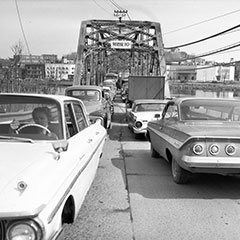Urbanization and Industrialization
The Industrial Revolution spread a wealth of new sounds. First off, the factory broke the connection between work and the fields. Before that, work was often accompanied by singing, since the rhythm of many tasks was in tune with a person’s breathing. It stemmed from the movement of hand and feet. Sailor tunes, farmer songs and the music of craftspeople set the pace.
Following the Industrial Revolution, the noises of technology and mechanical equipment swept over towns and the countryside. The sounds of nature faded away, drowned out by industrial machinery and household appliances. By the beginning of the 20th century, city-dwellers’ ears were well accustomed to the incessant noise of machines.
The sounds of industrial life won out over the sounds of nature. In factories, the machines were stopped only during lunch breaks, when child workers borrowing from their rest time cleaned them. The rest of the time machines kept up their racket while workers remained quiet – they were not authorized to speak.
The global increase of noise levels is a main characteristic of the industrial soundscape. Sounds of industrial life are relentless: a continual buzzing (like a generator); a “grainy” noise (like that of a mechanical saw or file); or a rhythmic sound (like a loom or a threshing machine).
Nowadays, because of the dangers to hearing health and general occupational safety, working conditions in factories have evolved. In addition to safety barriers around machines, employees have indirect contact with them and work in soundproofed, air-conditioned, glass control rooms. The compulsory use of hearing protection, and sometimes eye protection, ensures the worker is protected from the machinery’s incessant noise when he or she has to perform maintenance around it. Finally, whereas machines used to be stopped during lunch hours, workers now take their break in soundproofed rooms away from the racket of machines that continue to operate.
Factory Noises
Download audio (26 seconds, 0.40 MB)
We hear the different sounds you would hear in a factory: machines, metal parts clashing together, etc.
Source: Free sound bank
Sounds of the Kruger Plant, a Québec Company in the Pulp and Paper Industry.
Download audio (33 seconds, 1.27 MB)
Sounds of a modern paper machine, 2015.
Source: Boréalis. Year: 2015
Hop Aboard!
The internal combustion engine produces one of the basic and most ubiquitous sounds of modern civilization. This type of engine in fact motorized people. In the course of one day, in industrial societies, the average person can maneuver many internal combustion engines: cars, motorcycles, trucks, tractors, generators, lawnmowers, power tools, snowmobiles, and so on. These noises assail our ears during many hours each day: the sounds of traffic flowing or noisy traffic jams, the unrelenting sounds of city life.
Traffic on Decarie Boulevard in Montreal
Download video: MP4, (8,60 MB), WebM, (8,63 MB), Ogg (8,36 MB) (38 seconds)
Traffic on a metropolitan road.
Direction: Caroline Roy-Element
Traffic noises
Download audio (37 seconds, 1.42 MB)
Evolution of sounds related to road traffic, from horse carriages to trucks, including the hand-cranked car and the gasoline-powered car.
Author: Pierre Brouillette Hamelin


